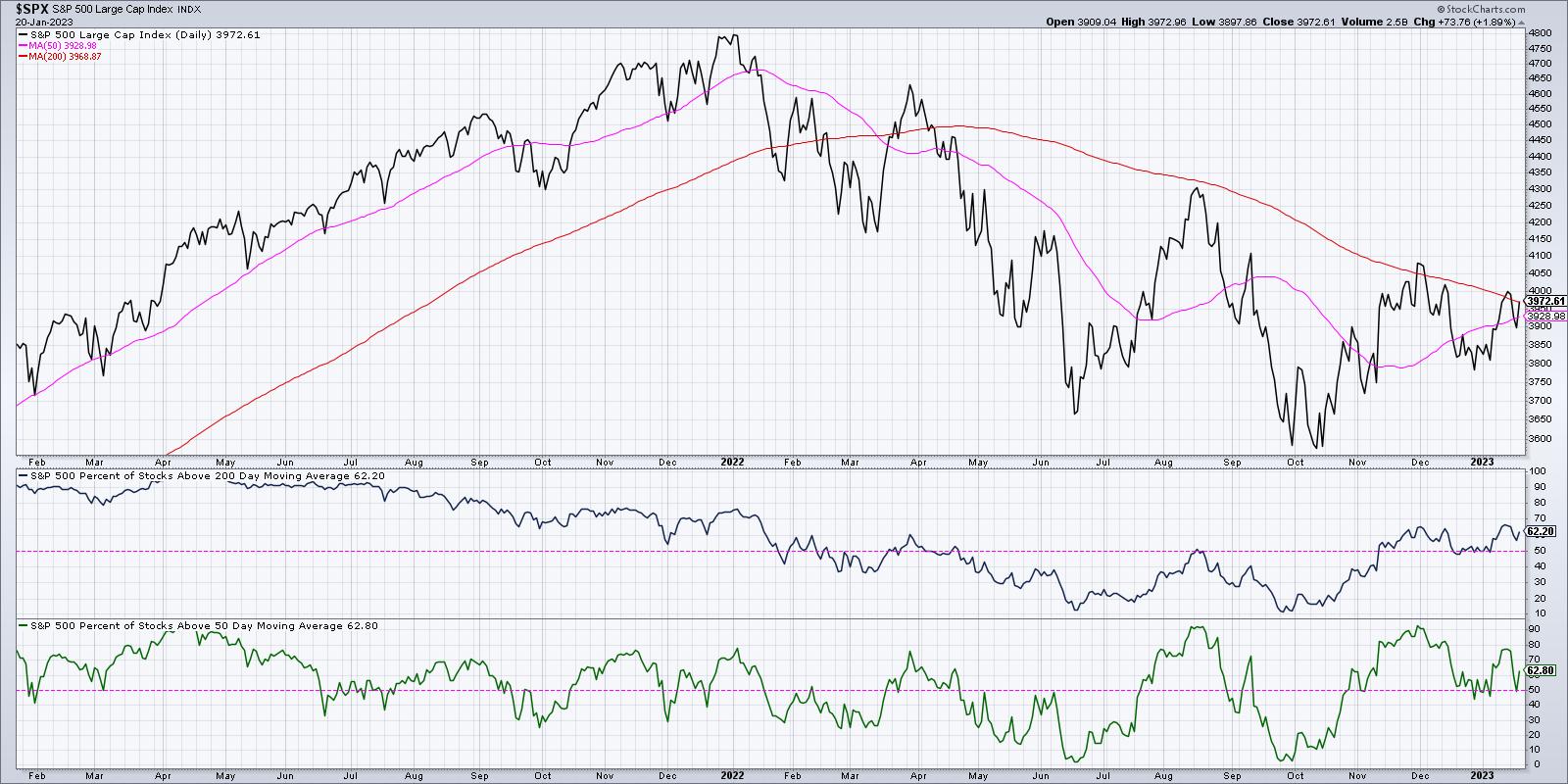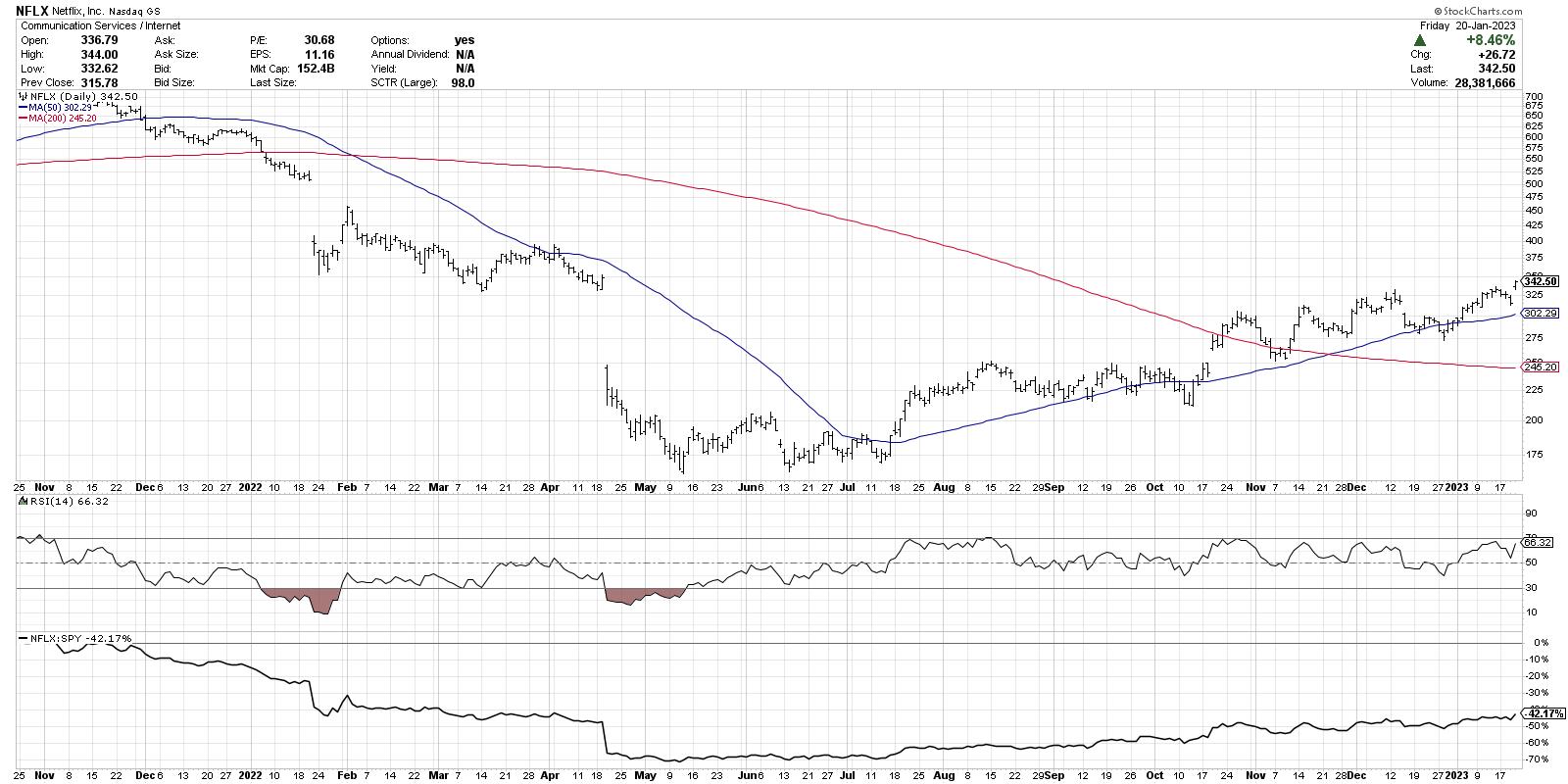I like to keep my process simple. That is, I define the market trend using a simple combination of exponential moving averages. It also means that my charts are relatively straightforward, avoiding too many indicators, and sticking to what I consider to be simple measures of trend and momentum.
So when I think of market breadth, I (unsurprisingly) prefer to keep it simple. Are More Than Half of S&P 500 Stocks Above Their 200-Day Moving Average? Then the conditions are pretty good. What if less than 50% of the benchmark names are above their 200-day moving average? Then the picture is probably much less rosy.
We’ll get to the main breadth indicator in a moment, but first let’s acknowledge the value of simple price comparisons using the moving average.
Everything starts with the 200 day
One of my early mentors used to say, “Nothing good happens below the 200-day moving average.” While there are indeed some positive things that could happen below the 200-day mark (bullish divergences come to mind), he was indeed right that conditions are far from ideal before this long-term barometer is breached.
GOOG’s chart over the past two years is a brilliant example of this approach in all its glory.
On the left half of the chart, you will notice that the price is making higher highs and higher lows. The price is above the 50-day moving average, which in turn is above the 200-day moving average. This chart is “long and strong” and flows up and to the right.
“A consistent, imperfect routine is far better than an inconsistent, perfect routine.”
What distinguishes successful investors from others? A commitment to a consistent set of routines. What’s the first chart you look at every day? What do you see, read and hear every day? How would you describe your daily and weekly routine?
In our latest free webinar, I’m going through my own morning coffee routine from start to finish. You’ll see what I use to maintain high situational awareness of the markets and find some ways to improve your own routines! Register HERE for this free event on Tuesday 1/24!
See how much things have evolved on the right half of the chart. The price is now making lower lows and lower highs. The price is below two moving averages sloping down. Conditions are clearly bearish.
Now let’s take this analytical approach and expand it into a breadth indicator to tell us more about broad market participation.
The most important latitude indicator of all time
OK, I’m getting a little aggressive with the superlatives, but this chart has certainly provided some excellent perspectives for stocks over the last 12 months. We are now basically reviewing 500 charts to see if the price is above or below the 200-day and 50-day moving averages.

You can see in the first box below the price that as of Friday’s close, 62% of S&P 500 members are above their 200-day moving average. Watch how the indicator stayed above the pink 50% line for all of 2021 and then fell below the crucial 50% mark in the first quarter of 2022. Notice how the indicator climbed to 50% but didn’t get past it. when the S&P 500 tested its own 200-day moving average in August 2022. You can also see how the indicator finally broke above the 50% mark in November as the market bounced off the October lows on a broad bounce.
Then, when the S&P 500 fell back to 3800 in December, this indicator stayed well above the 50% mark. This was a key bullish tell as I considered the likelihood of a retest of the October lows. As long as this indicator stays above 50%, conditions for stocks are still quite constructive.
Now let’s look at the bottom panel, which shows the percentage of stocks above the 50-day moving average. On Thursday of this week, the indicator fell to just below 50%, which is why we highlighted it as a possible breakdown The Thursday episode of The last bar.
But Friday’s rally on options expiry pushed that breadth indicator back up to 63%, meaning most stocks ended the week back above their 50-day moving averages. Investors often use the 50-day moving average as a good pullback indicator, and the fact that stocks are holding the 50-day price is a pretty bullish sign for the weekend.
What does a bull market recovery look like?
I think the Netflix (NFLX) chart is a good example of a rotation from a distribution phase (often described as more sellers than buyers) to an accumulation phase (buyers outweigh sellers).

See how the price is now above both the moving averages, the RSI has remained in the bullish territory (above 40) and the relative strength is trending steadily higher? The more stocks that have such a chart, the more likely our benchmarks are in an uptrend phase.
Friday’s trading session was propelled higher by FAANG shares and related names in the technology and communications services sectors. If we see more of this type of behavior in February, then perhaps we will see the type of bullish environment suggested by the four-year presidential cycle. For now, I’m focusing on this chart of market breadth indicators to see if they stay above the crucial 50% level. As long as this is true, the bullish recovery phase appears to be intact.
Would you like to digest this article in video format? Just visit my YouTube channel.
RR#6,
David
hp Are you ready to improve your investment process? Cash my youtube channel!
David Keller, CMT
chief market strategist
StockCharts.com
Disclaimer: This blog is for educational purposes only and should not be construed as financial advice. The ideas and strategies should never be used without first assessing your own personal and financial situation or without consulting a financial professional.
At the time of publication, the author has no position in the securities mentioned. All opinions expressed herein are solely those of the author and in no way represent the views or opinions of any other person or entity.

David Keller, CMT is Chief Market Strategist at StockCharts.com, where he helps investors minimize behavioral biases through technical analysis. He is a frequent presenter on StockCharts TV and links mindfulness techniques to investor decision-making on his blog, The Mindful Investor. David is also President and Chief Strategist at Sierra Alpha Research LLC, a boutique investment research firm focused on risk management through market awareness. He combines the strengths of technical analysis, behavioral finance and data visualization to identify investment opportunities and enrich advisor-client relationships.
learn more




